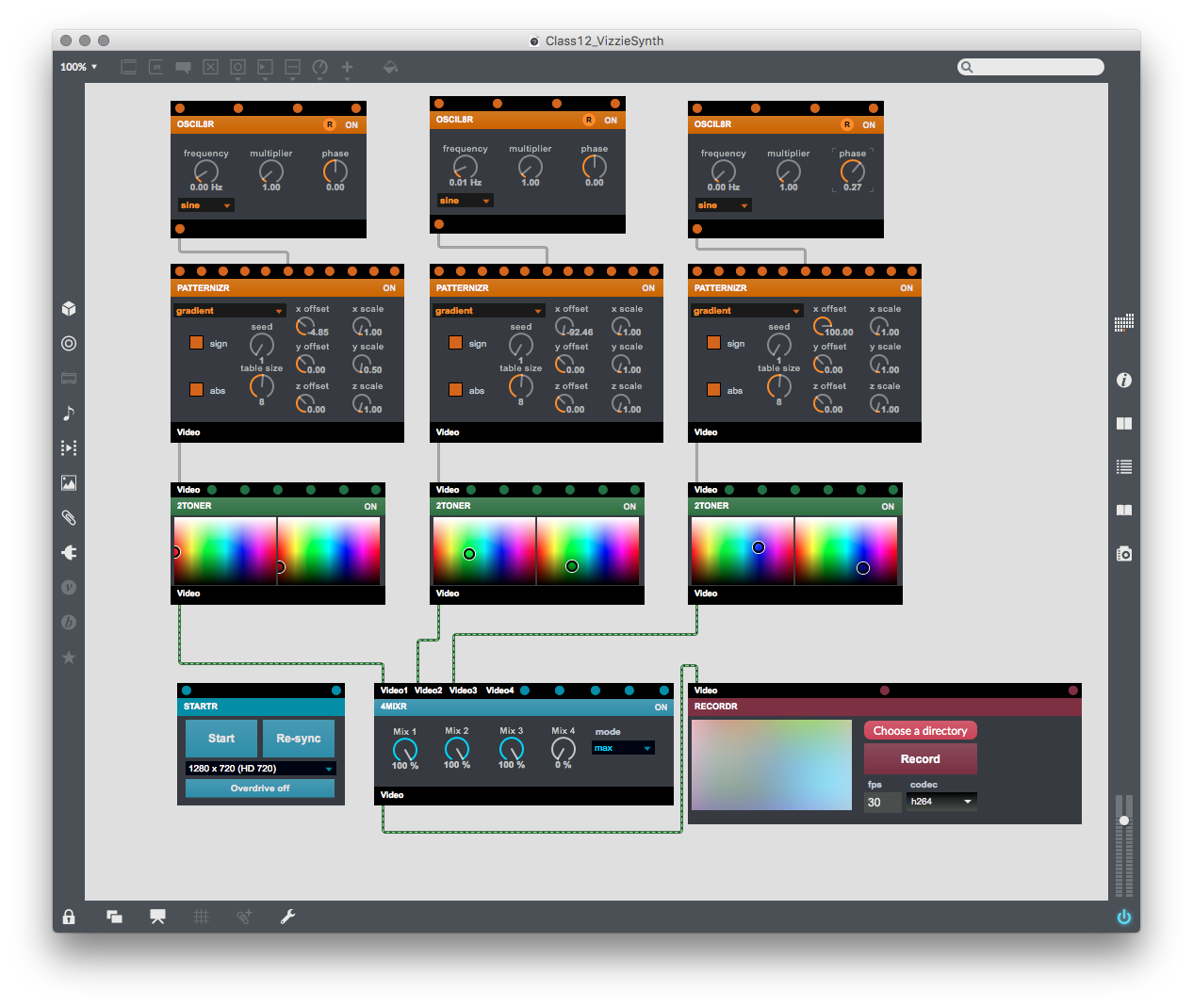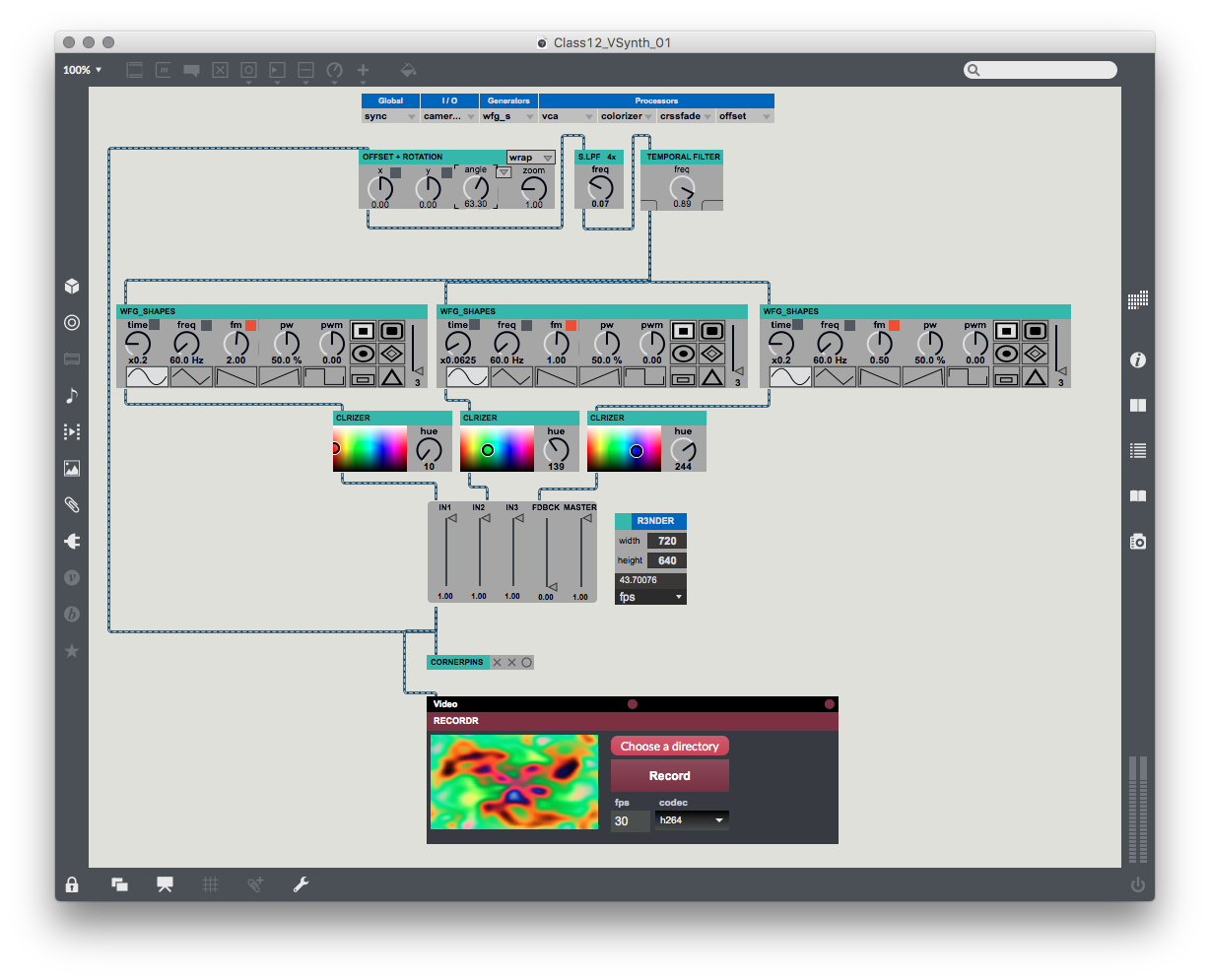Class 12 - Mar 01
- Video Synth
- Workshop, Demonstration, and Examples
- Video Signals Assignment Work Time
- Assignment:
- Video Signals Assignment (Video Synth)
- Reading:
- Mueller Chp. 6
- Tutorial:
- Announcements:
- Crossman Gallery: Reading Material
- Theater Dance: Street Scene
- Weekend Movie: Jumanji, Summers Auditorium, $1 w/ hawkcard
- Time Wasters:
- Jelly Mario by Stefan Hedman (VIA)
Historical Video Synthesis

To begin class today, we will look a little more closely at video synthesis. A brief introduction was given as part of our time wasters in a previous class session. Dan Sandin is considered one of the pioneers in applying the concept of a synthesizer to video signals. His work complements that of Nam June Paik, a pioneering video artist. In particular, Paik created a modified video monitor for performing the video signal as it is geneated - The Wobbulator. Sandin's approach is related in that the concept of performing or manipulating an electronic signal can have both video and audio output. In this video, Sandin demonstrates how his image processor works. As the system and process developed, Sanding went on to create a number of influential video art works like "spiral5PTL".
Contemporary Video Synthesis
There are a number of different directions that concepts related to video synthesis have taken. One of those is related to the resurgence and development of modular audio synthesis. LZX Industries designs modules for a patchable analog video instruments. Because they are patch programmable, one can develop and organize the video synthesizer however they would like. In a related thread, there is a community of artists and musicians that modify old (and new) equipment to create unexpected, glitchy, or synth like effects. This direction is known as circuit bending and has a long history with artists like Notendo (Jeff Donaldson) or Tachyons+ (Logan Owlbeemoth) to name just a few. Alternatively, the concept of analog video signal processing can be incorporated into a digital work flow. Video effects can be programmed or scripted in digital environments as well. There are several applications for mixing video in live contexts, of which Resolume and VDMX are popular. For a different level of control and development, there are examples of programming environments for interactive visuals. We have been using MAX but there are others out there ( VVVV, OpenFrameorks, etc). With MAX, there are additional tools and packages that people have developed to smooth out some of the workflow. Examples of this would be standalone applications developed at Signal Culture or the Vsynth Package.
Vizzie Video Synth

As we started working last week towards Assignment 5, we will look more closely at video syntehsis in MAX. The screenshot above is an example of one approach to video synthesis using Vizzie objects.
- Generate Data
- oscil8r
- 4oscil8r
- Wandr
- Twiddlr
- Cyclr
- Color Channels / Video Signal
- Patternizr
- PatternMappr
- Primr
- Controllers
- Manual Control, By Hand
- Other Generators for Automating
- Audio Reactive (see Vizzie Visions)
- Twistr
- Fadr
- Mixing Signals
- XFadr (2 signals, mix between)
- 4Mixr (4 signals, with blend modes)
- 2Switchr (2 signals, cut/switch between)
- Output
- Startr Preset (Change Output Size)
- Viewr (program/output preview in patch)
- Recordr (capture program/output, set location first)
- Projectr (program/output in separate window)
VSynth Video Synth

You might also consider exploring Vsynth for Assignment 5. It is a package that must be installed, but has a lot of the tools premade for synthesizing video signals.
- Vsynth Tutorial
- In MAX: File -> Show Package Manage
- Find and Install Vsynth Package
- Premade objects for video synthesis
- Similar in concept to LZX Industries, or "modular" approach
- Different system for adding objects
- Right Click Window -> Paste From -> Vsynth
- Blank Patch
- Default
- Add objects from Vsynth Menu
- Generators
- WFG_Shapes
- WFG
- and more
- Processors
- Colorizer
- Mixer_Feedback
- and more
- Generators
- WFG_Shapes
- WFG
- and more
- Output
- Cornerpins
- Vizzie Recordr
- Vizzie Startr (Change Output Size)
- and more
Work Time
Our studio work time will begin after our video screening, process demonstrations, and workshop. During the work time, students should continue working on Assignment 5. The assignment is open to allow you to explore using MAX for video manipulation with an emphasis on video synthesis. After recording some of your work from MAX, you will need to incorporate it in a Premiere project with your slate. You might also consider layering or adding effects in post as a way to extend the experimental processes of working with alternative ways of produce abstract visuals.
Our studio work time also affords you the opportunity to get feedback, suggestions, and ask questions about the assignment.